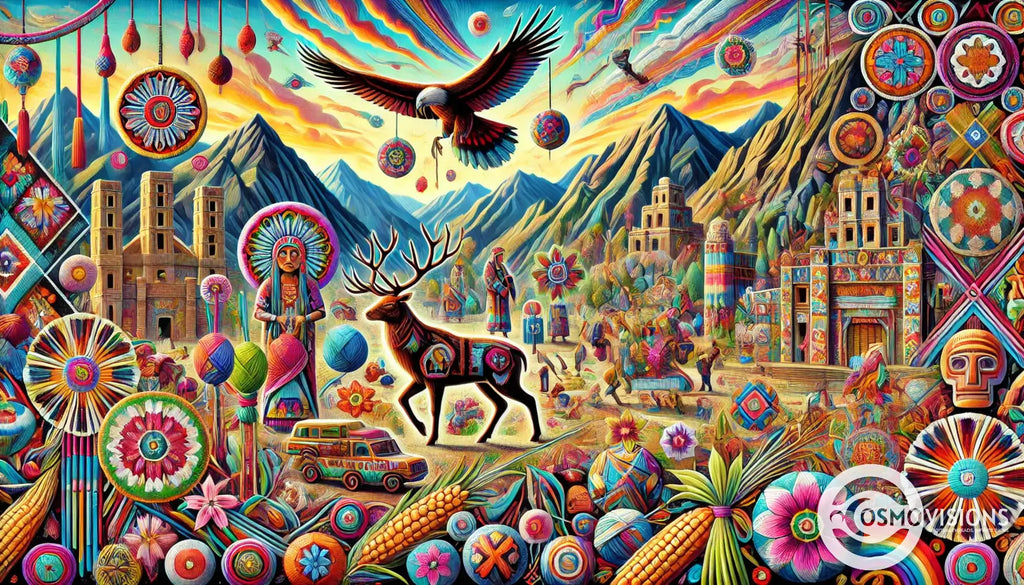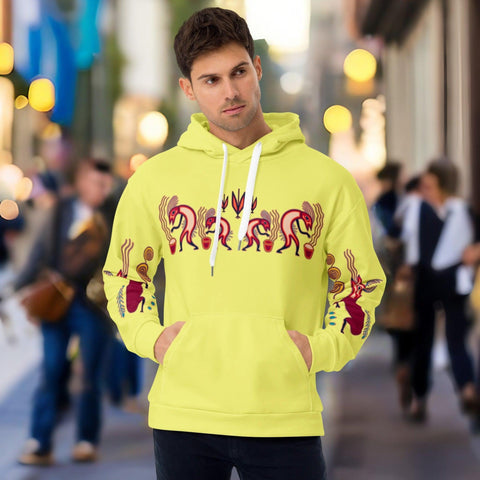Exploring the Rich Cultural Heritage of the Huichol Indians in Mexico today
Posted by Massimiliano Geraci

Ever wondered about the vibrant and rich culture of the Huichol Indians? These indigenous people, nestled in the Sierra Madre Occidental range across Mexico and parts of the United States, hold a magnificent cultural wealth waiting to be discovered.
This article will serve as your gateway into their world, guiding you through their history, language, folklore, astonishing art forms, rituals, and current struggles. Prepare to embark on an enlightening journey unlike any other!
Key Takeaways
1. Huichol Indians, or Wixárika people, live in the Sierra Madre Occidental range covering parts of Mexico and the US.
2. They have a unique Uto-Aztecan language and their lifestyle heavily involves farming and hunting.
3. Their religion is deeply tied to nature, featuring beliefs in spirits (Animism) with Peyote cactus playing an important role in religious practices.
4. Vibrant artwork like yarn paintings and beaded crafts play a crucial part in Huichol culture, telling stories about their traditions.
5. Challenges faced by the tribe today include maintaining religious freedom and dealing with environmental damages caused by modern development.
6. Organizations are making efforts to preserve this indigenous culture amidst these ongoing challenges.
Overview of the Huichol Indians
The Huichol Indians, also known as the Wixárika, are an indigenous group residing in the Sierra Madre Occidental range spanning Mexico and parts of the United States. Their history dates back to their first encounter with Europeans, mainly Spaniards who brought diseases that greatly impacted their population.
These resilient people communicate using a distinct Uto-Aztecan language encapsulating their rich cultural heritage. The lifestyle of the Huichols significantly intertwines with nature - farming and hunting remain vital aspects of their daily life.
Location (Sierra Madre Occidental range in Mexico and the United States)
The Huichol, or Wixárika people have long made the Sierra Madre Occidental range their home. Straddling both Mexico and the United States, this rugged landscape spans portions of Nayarit, Jalisco, Zacatecas, and Durango states in Mexico.
Settlements within these majestic mountains are sparse and typically centered around mining sites and farming hamlets. This mountainous zone's rich biodiversity plays a considerable role in nurturing the vibrant culture of Huichols while providing sustenance to support their traditional lifestyle rooted deeply in respect for nature.
History (first European contact, impact of European diseases)
The story of the Huichols intertwines with the arrival of Europeans on Central Mexican soil. Spanish conquistadors initiated first contact in the 16th century, though vast Sierra Madre Mountain range largely shielded the Huichol tribe from early encroachment.
Yet, inevitable encounters introduced new hardships for these indigenous people.
A wave of devastating epidemics swept through after their arrival because Spaniards unknowingly harbored a host of foreign diseases to which Huichols had no immunity. Smallpox, Measles and other 'Old World' plagues decimated local populations that had thrived before European contact caused such unintended havoc.
This bleak period dramatically marked Huichol's history, upsetting their way of life and significantly dwindling their numbers.
Language
The Huichol language, a Uto-Aztecan language, fosters the cultural identity and unity among the indigenous Huichol people. Spoken by around 20,000 individuals in central Mexico and parts of the Sierra Madre Occidental range, it is closely related to Cora, another regional dialect.
This fundamental aspect of daily life underscores tribal communication and ceremonies but remains purely verbal as no recorded written system exists for the Huichol Indian language.
Lifestyle
The Huichol Indians primarily indulge in subsistence farming, cultivating staple crops like corn, beans, and squash and partaking in animal husbandry. Preserving an agricultural way of life is a critical component of their survival strategy stating the semi-nomadic lifestyle.
Steeped deeply within the foundations of this culture are unique art forms and spiritual practices coupled with daily rituals, profoundly shaping ancestral folkways and customs. These rich elements reflect across everything they create — from food to craftwork, making theirs a thriving cultural heritage yet largely untouched by the modern world.
Religion and Mythology
Delve into the fascinating world of Huichol beliefs, where animism coexists with a profound reverence for peyote in their religious practices. Dive deeper to unravel how this sacred plant shapes their understanding of spirituality and existence.

Animism and belief in spirits
The Huichol Indians display a vibrant connection with the world around them through their belief in Animism. The essence of this belief lies in the conviction that everything, including objects, places and creatures, carry a unique spiritual presence.
In the heart of Huichols' religion resides an unshakeable faith that nature is imbued with spirits - each tree, stone and river possesses its own life force.
Playing vital roles in guiding Huichol toward their animistic practices are the Shamans or Mara'akame. They serve as intermediaries between humans and spirit entities known as Aramara, Father Sun and Grandfather Fire.
A potent demonstration of these beliefs unfolds during Peyote hunts where rituals involve singing to ancestor spirits to ensure bounty. Consistently central to all activities conducted by this ethnic group from Sierra Madre Occidental range is respect for every aspect of nature symbolizing animated life within them.
Importance of peyote in religious practices
Peyote, a small spineless cactus, holds great importance in the religious practices of the Huichol Indians. As one of their four principal deities, it serves as a physical embodiment of their gods and is given high reverence in ceremonies and customs.
The shamans employ peyote during spiritual rituals to communicate with divine entities, receiving visions and messages from the gods. This exchange enables them to gain insights into prophecies or enlightened wisdom for healing purposes within their community.
Generations have upheld this sacred practice, demonstrating its central role in perpetuating Huichol religious traditions and preserving cultural identity.
Art
The art of the Huichol Indians is steeped in rich symbolism and cultural significance, with traditional forms ranging from intricate beadwork to vibrant yarn paintings. Unearth more about their captivating artistic heritage as we delve deeper into this exciting realm!
Traditional Huichol art forms
The Huichol Indians produce stunning pieces of art rooted in their spiritual and cultural traditions. These traditional handicrafts often feature vibrant yarn paintings, intricate beaded masks, and revered ceremonial objects.
As a form of written communication, the colorful art captures unique stories and myths from Huichol culture. The materials used have evolved over time; small beads and yarn now replace original clay or stone materials.
Each artistic creation holds symbolic importance—it represents either an event in the artist's life or illustrates their understanding of the world around them.
Symbolism and cultural significance in art
Huichol art acts as a vibrant bridge, linking the physical world to the realm of deities and ancestral spirits. Embroidered with symbols deeply ingrained in their culture and spirituality, each creation tells a captivating story of Huichol's relationship with nature and gods.
The symbolism evident in these artistic expressions carries profound cultural significance, reflecting rituals, mythology, spiritual beliefs, and vital life events.
Colorful beads sculpted into striking figures or mesmerizing yarn paintings depict scenes from Huichol folklore, such as the sacred peyote hunt or intricate visions during shamanic journeys.
Each symbol used - an eagle representing the heavens' reach or a deer illustrating innocence - contributes to narrating compelling tales that form part of their oral tradition passed down through generations.
This truly makes Huichol art not just visually pleasing but also culturally enriching.

Current Issues
The Huichol Indians face modern challenges from religious freedom restrictions to environmental impacts, threatening their age-old culture and practices. Discover how these issues are being addressed to preserve a vital part of Mexico's rich cultural heritage.
Keep reading!
Religious freedom and preservation of traditional practices
The Huichol Indians, like many Native American communities, face significant challenges in maintaining their religious freedom and conserving traditional customs. Efforts at protection are often inconsistent and insufficiently comprehensive despite federal policies such as the First Amendment and the American Indian Religious Freedom Act of 1978.
The Huichol’s uniquely spiritual connection to nature takes form in their reverence for deities like Corn, Blue Deer, Peyote, and Eagle – all children of their Sun God, Tao Jreeku.
Unfortunately, access to sacred sites integral to these worship practices is not always guaranteed or protected. Adding insult to injury is the fact that cases brought before the U.S Supreme Court aimed at safeguarding indigenous religions seldom win favor.
Nevertheless, these traditions hold a deep significance within the culture and social infrastructure of tribes such as the Huichols, making it paramount that more needs be done towards tangible preservation efforts.
Environmental impacts of modern development
Modern development is drastically affecting the environment of the Huichol Indians. Due to urban growth and industry demands, excessive deforestation heavily pressures their traditional lumber practices and threatens forest quality.
The use of pesticides exposes these mostly indigenous communities and migrants to health risks influenced by structural factors both contemporary and historical. Further damage comes from environmental toxins produced, used or discarded in their territory.
These harmful materials intrude on the collective and individual rights of Indigenous Peoples like Huichol, causing lasting impacts on their culture, traditions and well-being.
Cultural Survival and Heritage
Discover the rich cultural heritage of the Huichol tribe, their traditional rituals, and the heartwarming efforts being put to keep their culture alive in our modern world. Stay tuned for a deep dive into an intriguing indigenous society and its fight for survival.
Ceremonial traditions and practices
Huichol Indians express their deeply held spiritual beliefs through abundant ceremonial rituals. These sacred ceremonies often include singing, dancing, and storytelling, which serve as remembrances of ancient tales passed from generation to generation.
One pinnacle tradition is the annual peyote hunt - a sacred journey led by highly respected shamans to gather enough peyote cacti used in healing and visionary rituals throughout the year.
During special events like birth rites or funeral services, it is common to see artwork created with vibrant yarn paintings or intricate bead crafts symbolizing Huichol's connection to nature and gods, such as Father Sun and Grandfather Fire.
Extensive knowledge about deer spirits derived from centuries-old mythology forms another significant part of their ceremonial practices.
Efforts to support and preserve Huichol culture
Non-profit organizations like the Huichol Center for Cultural Survival and Heritage play a vital role in preserving Huichol culture. They execute well-planned strategies to tackle economic, health, and educational challenges that threaten preserving this unique culture.
The center actively involves members from different Huichol communities, encouraging them to keep their spiritual heritage alive through artistry and cultural practices. Despite the encroaching modern world, Huichols are determined to maintain their customs and language intact—a testament to their resilience.
Huichol Indian Village Tour
Embark on a unique journey through guided tours in the Huichol villages within the Sierra Madre Mountains; an unmissable opportunity to immerse in the rich Huichol culture and traditions.
Delve deeper into the heart of ancient practices, vibrant artistry and unparalleled spiritual beliefs that persist till today - explore more about this fascinating voyage as you continue reading.
Experience the Huichol culture and traditions through guided tours
Guided tours are your passport to immersing yourself in the captivating Huichol culture and traditions. By partaking in these tours, you gain firsthand exposure to the colorful and elaborate rituals that make this indigenous community unique.
These authentic experiences occur at ceremonial centers like temples, serving as an incredible testament to Huichol spiritual practices.
Breathtaking mural-like yarn paintings, beautifully intricate beadwork, and textile art steeped with symbolism are among the artistic marvels of the Huichols that visitors feast their eyes on during the tour.
With each piece central to conveying religious beliefs and cultural heritage, art is vital for tourists to engage with and understand Huichol culture. As proponents of environmental reverence, echoes of nature's sanctity resonate profoundly within every aspect of their artwork showcased during your visit.
Location of Huichol villages in Sierra Madre Mountains
Nestled within the heart of the Sierra Madre Occidental mountain range are small villages called ranchos, proudly home to the Huichol Indians. This expansive region in Mexico's central western region provides a bountiful and culturally enriching setting for these indigenous communities.
The majority of the Huichol population call this stunning mountainous terrain their homesteads, specifically flourishing near Ixtlan. Their neighbors in this rugged landscape include other native groups such as Cora and Tarahumara (Rarámuri) peoples.
Thus, within Mexico’s cherished Sierra Madres exists a vibrant tapestry woven with the rich traditions and lives of several indigenous tribes, including that of our focal tribe – The Huichol.

Conclusion
Huichol Indians are significant contributors to the colorful tapestry of Mexican culture with their vibrant traditions own language and artistry. Havens of living history, their communities offer a snapshot into ancient customs beautifully preserved in modern times.
Their resilience as indigenous people showcases survival and a constant evolution within art, spirituality, and lifestyle - painted against the stunning backdrop of the Sierra Madre mountains in Mexico.
We cherish the Huichol for bringing life lessons about maintaining cultural heritage amidst rapid global development.
Where do the Huichol Indians live in Mexico?
The Huichol families live together primarily in Jalisco, San Luis Potosí, Nayarit and Durango in Northwest Mexico.
What is the Huichol tribe's relationship with the San Luis Potosí region?
San Luis Potosí, home to Wirikuta, is a sacred location in the Huichol religion. Here, the Huichol people undertake an annual pilgrimage to retrace the steps of their ancestors and collect peyote for their religious rituals.
What is notable about the religion of the Huichols?
Their religious rituals greatly emphasize elements of the natural world and engage with animals using traditional practices inherited from Pre-Columbian customs, including pilgrimage to sacred places like Wirikuta.
How is the lifestyle among The Huichol today influenced by pre-Spanish conquest traditions?
Even amidst interventions from Mexican government, they continue to uphold ancestral practices such as making cheese from milk, consuming wild fruits and vegetables alongside maize-size part of their food intake- indicating survival of Indigenous culture within modern day Mexico.
Do we see expressions of Huicholian heritage beyond lifestyle habits?
Yes! Beyond daily life patterns, artistic sector also showcases profound influence through the creation uniquely stylized artwork yarn paintings reflecting views on cosmology plus aspects regarding themes involving nature.
What is notable about the religion of the Huichols?
Their religious rituals greatly emphasize elements of the natural world and engage with animals using traditional practices inherited from Pre-Columbian customs, including pilgrimage to sacred places like Wirikuta. The Huichol Mara'akame, the spiritual leader, leads the Huichol practices. Rituals often involve pilgrimages, consumption of peyote, and other pre-columbian practices that connect them to their ancestors and the sanctity of nature.
How does the Huichol tribe view peyote?
For the Huichol tribe, peyote is more than a plant. It is part of the Huichol religion and customs. Consumption of peyote is an integral part of the sacred journey of the Huichol. It is believed to help heal oneself and connect with the Huichol world of the ancestors.
What efforts have been made by the Mexican government to protect the Huichol culture?
A: With the support of organizations such as UNESCO, the Mexican government has tried to protect a section of the Huichol way of life. This includes efforts to conserve sacred places like Wirikuta, encouraging the survival of the indigenous Huichol language, and preserving Huichol art.
How do Huichol people live and work?
Huichol families live together in small communities. The Huichol people dedicate much of their lives to religious practices and artwork, with maize cultivation also central to their lifestyle.
Tell me about the Huichol art.
Huichol art is famous worldwide for its vibrant color and intricate details. It often portrays elements of the Huichol religion and customs. Huichol's artwork also includes designs inspired by their visions during the peyote rituals.
How does the Huichol tribe incorporate corn into their customs?
Corn, or maize, is a fundamental part of Huichol culture. It is grown by the Huichol people, used as a staple food, and given profound significance in their religious rituals.
What is the native Huichol language?
The native Huichol language, known as Huichol or Wixárika, belongs to the Uto-Aztecan family. This language is still spoken among the Huichol, and efforts have been made to preserve it for the future Who are the Huichol Indians?
The Huichol Indians are one of the ethnic groups that inhabit Central Western Mexico, living their own unique way and upholding many pre-Columbian traditions.





















